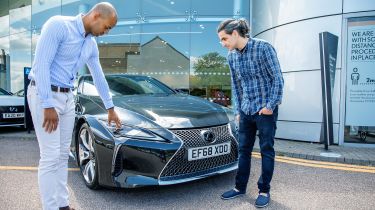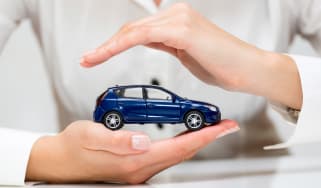How to test drive a car: top tips
A test drive is a key part of the car-buying process but there are some important points to remember. We cover what to do and what to avoid

Test driving a car is a vital step in deciding whether a certain make and model is right for you. Reading an in-depth review will help guide you towards your ideal car, but nothing is more helpful than sitting behind the wheel for yourself. Test driving a car is usually a straightforward process, but there are certain things to bear in mind in order to get the most out of your time in the driver’s seat.
When test driving a car, it can be all too easy to follow your heart and not your head, so before visiting the showroom and getting behind the wheel, it’s important to make note of what you want from your new car. If you have an attachment to the car prior to driving it, because you happen to like how it looks or it seems like a bargain, you may end up ignoring its shortcomings. Combine this with clever sales staff trying to persuade you the car you’re testing is the perfect one for you, and a test drive can become an overwhelming experience.
In this guide, we cover the key things to consider when test driving a car, as well as the best practices and things you should avoid doing.
What should I consider before test driving a car?
Before you even step foot in the dealership, we recommend that you make a list of the key criteria your new car must meet. How many passengers will be travelling in the car? Am I better off with a hybrid or electric car instead of a traditional combustion engine? How big does the boot need to be? What must-have interior features do I want?
When the time comes to test the car, these requirements should be at the forefront of your mind. Make sure to ask your dealer any questions you may have, as a test drive may not reveal everything you want to know.
Test driving a car: things to do
Test driving a car should ideally be a straightforward, informative, and enjoyable experience, and the dealer will be available to address any queries you may have. Here is a summary of the key things to do when test driving a car.
- Bring the family along – if you’re buying a family car, it’s worth taking everyone along. It’s not just you who’ll be using the car, after all, and there may be practical aspects others will spot that you might miss on your own.
- Test all the gadgets – does everything in the interior work as it should and are the controls easy to use? Ask the dealer what comes as standard fit and what equipment you’ll have to pay extra for.
- Test drive on a variety of roads – sticking to straight, smooth roads won’t paint an accurate picture of the car’s handling and suspension qualities. Ask the dealer if you can test the car across a variety of roads with varying speeds and surface quality.
- Ask questions – If you’re buying from a dealer, you can’t ask too many questions or take too long to decide – they’re there to help you. Asking for a second test drive is also perfectly reasonable.
Test driving a car: things to avoid
Of course, there are also things to avoid doing in order to get the most out of your test drive. Here’s a summary.
- Don’t just follow your heart – Test driving a car should be an objective process. While you may be swayed by a car’s looks or a tempting deal, you may end up regretting your purchase if it doesn’t tick all of your essential needs.
- Don’t be overly gentle – We’re not recommending you thrash a test car, but don’t just cruise along either. Make sure it pulls strongly throughout the rev range without making any untoward noises, and that you get to shift into higher gears.
- Don’t test just one car or model – Without testing a variety of cars, you’ll struggle to determine which is the best for you. The same is true for different engine options for a particular car – trying more than one will only help you find the one that’s right for you.
- Don’t turn up unprepared – Make sure to do your research beforehand, and check that the car is available for you to test drive. Have an idea of what it is you want and what questions you need to ask. Reading one of our best lists or in-depth reviews is a good place to start.
Am I insured?
Insurance is unlikely to be a problem, particularly if you’re buying from a main dealer, but it’s worth thinking about nonetheless. A dealer will want to take a copy of your driving licence for their records and should cover you fully on their insurance. If you’re buying from a private seller, it’s likely the insurance will need to come from your side.
You’ll need fully comprehensive insurance to do this, and even then this is likely to only provide third-party cover when you’re driving someone else’s car. Make sure that you and the seller are happy with this. It’s unlikely you’ll have an accident on a test drive, but with third-party insurance, you may end up with the bill for any damage to the seller’s car. A phone call to your insurance company before going out to test drive privately is usually a good idea.
How to test drive a car
It’s often said that buying a car should be a pleasurable experience, but that’s only partly true: test driving and choosing the car should be an objective process. Taking possession of and driving away in the right car is the pleasurable bit, and conducting a thorough test drive should help ensure you make the correct choice. Below, you’ll find the key things to look out for during your test drive.
Is it big enough?
Before driving the car, you should already have an idea of how many passengers you’ll be carrying and how much space you’ll need. With this in mind, it’s worth making a list of questions to tick off as you go along: is the boot really big enough? Can two adults sit in the front with child seats behind them? If you have a pushchair or golf clubs, or any similarly bulky items you regularly want to carry, do they fit in the boot easily? Ideally, arrange a family test drive and get some time on your own with the car.
Check for faults
If you’re buying from a main dealer, any car they’re offering for sale should have passed a comprehensive pre-sale inspection, but even new cars can pick up minor damage during transportation. While this should have all been checked before it made it into the showroom or onto the forecourt, you’re buying something worth thousands of pounds, so it’s best to be vigilant.
While defects are often covered under warranty, insisting they’re attended to before you drive away can save a lot of hassle later. Keep an eye out for scuffs or small chips to the car’s exterior and wheels, as well as any signs of use or wear inside the cabin, including bad smells. Obviously, the condition of the car depends on its age but if you’re buying new, the car should be perfect, inside and out.
 What is a mild hybrid? MHEVs vs other hybrids explained
What is a mild hybrid? MHEVs vs other hybrids explained
Of potentially greater importance are the car’s mechanicals. Check the engine temperature, either by the dashboard gauge or by placing a hand on the bonnet of the car. Is there a reason the seller isn’t letting you start it from cold? A warm engine can cover up untoward rattles or starting difficulties.
Used-car mechanicals present potential problems, so you may want to consider an aftermarket warranty if the dealer does not provide one of their own. Even seemingly small niggles may cost you dear – there may well be a reason the dealer did not fix them themselves. If you still want the car despite any faults you find, either use them as bargaining chips to get the price down or ask the seller to remedy them before you buy. See our comprehensive guide on car purchasing for more details.
Inside the car
Despite this being a test drive, don’t feel the first thing you have to do is actually drive the car. Get inside and consciously spend a few minutes getting the seat comfortable, the mirrors adjusted and the ventilation system angled how you like it. Familiarise yourself with the major controls, too.
Once you’re happy, comfortable and understand how things work, start the engine and keep an eye on your mirrors for any signs of smoke. Next, turn the steering wheel fully to the left and right, listening for any clunks from the suspension or loud whining sounds from the power steering.
Taking this measured, considerate approach before you drive the car can help you remain objective when it’s time to drive. If you’re still happy with the car at this stage, now is the time to take it for an actual drive.
Driving the car
Make sure the car accelerates smoothly and brakes effectively with precision, and continue to listen out for strange noises or vibrations. Driving on a variety of roads is ideal – taking the car on fast dual-carriageways, slow country routes and stop-start town roads with speed bumps should give you an idea of how it behaves in most of the situations you’re likely to be driving it. Consider visibility – are the front and rear blind spots particularly large and how easy is it to manoeuvre the car in reverse?
 Do electric cars have gearboxes?
Do electric cars have gearboxes?
Try to think about the type of driving you’ll be doing in the car. If you mainly commute in town, do you really want an aggressively shifting sporty gearbox? If you’re more of an enthusiastic driver, does the car have enough overtaking power for you? If you’re unsure, it’s a good idea to test drive the same model with a different engine. You may find that you’re just as happy with a smaller engine and could save yourself some money.
If you’re test driving an electric car, take note of the indicated battery charge level and the estimated range when you set off. This will give you a clear indication of the real-world range you can expect, and it will likely be different from what’s quoted in the brochure.
Some dealers – particularly volume-selling car supermarkets – may be reluctant to give you an extended test drive. Be sure to explain to the seller that you expect to be able to fully assess the car before purchasing it.
The technology
Make sure you spend a good deal of time checking the gadgets and features of the car. Advanced in-car technology is a wonderful thing, but it can be expensive to fix if it goes wrong.
Does the air-conditioning blow cold? If the car you’re looking at has extras such as heated seats, satellite navigation or Apple CarPlay and Android Auto connectivity, do they work as they should? Try pairing your phone to the car, or have the navigation on for a portion of the test drive. If the car has any driver assistance features, such as lane-keeping assistance or adaptive cruise control, be sure to test these during your test drive as well.
You’re not just assessing the condition of the car and its features, you’re finding out how useable it is for you. Being stuck with the wrong car can be a daily headache, and extra time spent with the car before purchase could save you a lot of annoyance after you’ve paid for it.
Most importantly, remember that you’re in control. Buying a car is the second most expensive purchase most of us will ever make in our lifetime, so it’s important to be satisfied with what you buy. As long as you haven’t paid anything towards the car, you’re free to walk away at any time; don’t feel pressured into buying the car simply because you’ve taken it for a test drive - they exist to help you make a decision.
Check out our useful guide to the 20 car buying secrets that dealers don't want you to know and everything you need to know about the V5C logbook
Recommended

Petrol and diesel car ban relaxed with hybrids permitted beyond 2030

Classic car tax exemption: which historic vehicles qualify?

Car warranties: guide to new and used car warranties
Most Popular

New Smart #5 Brabus is a 637bhp far cry from the brand’s city car past

Best car leasing deals 2025: this week’s top PCH offers
Tips & advice

Car dashboard warning lights: what does each symbol mean?

Electric car charging stations: public networks, charger types, apps and maps







